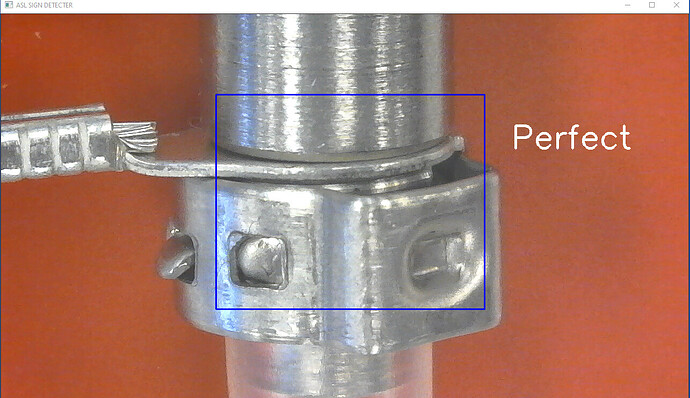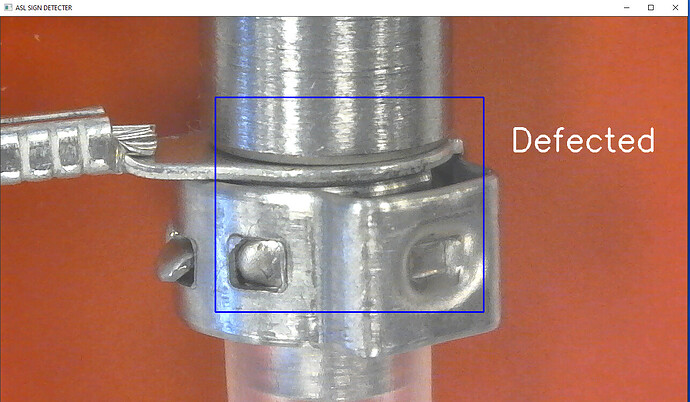Hello, I am using a code to classify real time image, But I am confused about it. Could you please take a look on the code and help me to figure out any error:
import numpy as np
import torch
import torch.nn as nn
import torchvision
from torch.autograd import Variable
from torchvision import transforms
import PIL
import cv2
#This is the Label
Labels = ['Perfect','Defected']
# Let's preprocess the inputted frame
data_transforms = torchvision.transforms.Compose([
torchvision.transforms.Resize(size=(352, 288)),
torchvision.transforms.RandomHorizontalFlip(),
torchvision.transforms.ToTensor(),
torchvision.transforms.Normalize(mean=[0.5, 0.5, 0.5], std=[0.5, 0.5, 0.5])
])
device = torch.device('cuda' if torch.cuda.is_available() else 'cpu')
# Load the model and set in eval
resnet18 = torchvision.models.resnet18(pretrained=True)
resnet18.fc = torch.nn.Sequential(nn.Linear(resnet18.fc.in_features,512),
nn.ReLU(),
nn.Dropout(),
nn.Linear(512, 2))
resnet18.load_state_dict(torch.load('defect_classifier_demo.pt', map_location=torch.device('cpu')))
resnet18.eval()
#Set the Webcam
def Webcam_720p():
cap.set(3,1280)
cap.set(4,720)
def preprocess(image):
image = PIL.Image.fromarray(image) #Webcam frames are numpy array format
#Therefore transform back to PIL image
print(image)
image = data_transforms(image)
image = image.float()
#image = Variable(image, requires_autograd=True)
image = image.cpu()
image = image.unsqueeze(0) #I don't know for sure but Resnet-50 model seems to only
#accpets 4-D Vector Tensor so we need to squeeze another
return image #dimension out of our 3-D vector Tensor
#Let's start the real-time classification process!
cap = cv2.VideoCapture(0) #Set the webcam
Webcam_720p()
fps = 0
show_score = 0
show_res = 'Nothing'
sequence = 0
while True:
ret, frame = cap.read() #Capture each frame
if fps == 4:
image = frame[100:450,150:570]
image_data = preprocess(image)
#print(image_data)
prediction = resnet18(image_data)[0]
torch.nn.functional.softmax(prediction, dim=0)
#result,score = argmax(prediction)
prediction = prediction.cpu().detach().numpy()
predicted_class_index = np.argmax(prediction)
predicted_class_name = Labels[predicted_class_index]
print(prediction)
print(predicted_class_index)
print(predicted_class_name)
#print(result)
#print(score)
#prediction = np.vectorize(prediction)
fps = 0
if prediction.any():
show_res = predicted_class_name
show_score= prediction
else:
show_res = "Nothing"
show_score = prediction
fps += 1
cv2.putText(frame, '%s' %(show_res),(950,250), cv2.FONT_HERSHEY_SIMPLEX, 2, (255,255,255), 3)
#cv2.putText(frame, '(score = %.5f)' %(show_score), (950,300), cv2.FONT_HERSHEY_SIMPLEX, 1,(255,255,255),2)
cv2.rectangle(frame,(400,150),(900,550), (250,0,0), 2)
cv2.imshow("ASL SIGN DETECTER", frame)
if cv2.waitKey(1) & 0xFF == ord('q'):
break
cap.release()
cv2.destroyWindow("ASL SIGN DETECTER") ```
